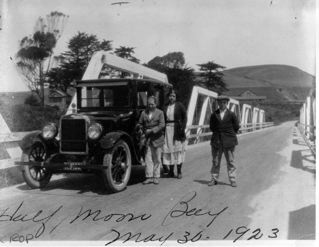Photo: Former Coastsider/Stained Glass Artist Peter Adams
See more of Peter Adams and his recent stained glass pieces: http://flickr.com/photos/zanador

Created by June Morrall
Photo: Former Coastsider/Stained Glass Artist Peter Adams
See more of Peter Adams and his recent stained glass pieces: http://flickr.com/photos/zanador
Joe “The Bartender’s” Flying Experience (2)
Original story by Fayden
This is about 1973 at a house on Birch Street in Montara where “Dirty” Ernie (we called him “Dirty” Ernie because he liked it), Chuck Portz, the “Turtles” old bass player, my first wife and I lived. In this house we played music until all hours of the night and drank like fishes.
We used coal for heat and totally polluted the neighborhood for a week while we used up the big bag of coal we bought in the pot belly stove. We went back to wood when we saw what it was doing to the air. No one ever complained, we assumed, because they all drank like fishes, too (at least. the closest neighbors seemed to).
“Dirty” Ernie was a short little Italian guy, deaf as a door nail, bald on top with a massive mustache. He’d walk into any social situation, yelling, “Hey, no laughing tonight,” and everybody knew it was Ernie and they would laugh and then return to whatever they were doing.
Chuck was a portly man who was building a large ferro craft boat about 55-feet long out in the backyard. He worked in a fiberglass factory that manufactured shower stalls and he was a commercial abalone diver. Chuck owned a black Labrador Retriever that lived in the fiberglass warehouse and he bragged that the dog could actually sit down on the toilet in the restroom to do his business.
Other locals, including Ernie, Don, Gary, Orville and myself were also commerical divers. Problem was we didn’t really like processing the abs, so we’d trade Dwayne, the butcher at a local market, for anything that didn’t taste like fish!
…to be continued..
Joe “The Bartender’s” Flying Experience (1)
Original Story by Fayden
Just after David Greenberg, Mike Mindel and Peter Rogers gave up managing the Spouter Inn that changed its name to the Shelter Inn (I was the music manager, by the way; I booked our acts) two new older, straight-looking guys came in to run things.
Joe and Doogie were their names. Doogie had red hair (kind of a disco cut) and good-sized mustache. Joe was a large man, stood about 5’9″. Joe had thinning hair and gained popularity singing songs like “The Temple Bar at Morys,” like “Crazy” Googinheim did on the Jackie Gleason Show towards the end of his t.v. show. Kind of an A Cappella college glee club voice, or like the buzzard talked on the Muppet Show.
These two were also the people who changed the name of “The Shelter Inn” to “The Miramar Beach Inn.”
Joe and Doogie started having electric bands playing there rather than what had up to this time been a folk or folk/rock genre, leaning aggressively to the acoustical. Admittedly, it was probably a good idea; it pumped everybody up and they bought more drinks. We had encouraged a more coffee house feeling where you could nurse a glass of wine without being pressured into getting bombed.
Ok. Enough about how Joe and Doogie ruined the best folk club on the coast where John Lennon, Yoko Ono, Jose Feliciano, Hot Tuna, me, etc., had played!
….to be continued…
From the San Francisco Call, December 7, 1912
“It is regrettable that the railroad commission found it advisable to permit the Ocean Shore railroad to discontinue the operation of a northbound train reaching San Francisco at 8:40 a.m. Morning communication is still maintained between Half Moon Bay and San Francisco, but at an early and inconvenient hour. Property owners who invested in homes along that railroad did so with the towns along the Ocean Shore would be actually suburban to San Francisco. The curtailed service will work serious hardship upon them during the winter months.
“Some day the Ocean Shore railroad will be a successful road. Natural conditions, the fertile land through which it passes, the scenic attractions of its route along the Pacific, the rapid transportation it will furnish, when completed, between San Francisco and Santa Cruz and the potential freight along its tracks and proposed route insure a remunerative traffic. But now it is in a bad way.
“Ultimately this road will be taken over by a bigger system, completed and made tributary to a continental line. California has room for the construction of new roads. The proposed line from Watsonville into the San Joaquin valley might make beneficial connnection with the Ocean Shore; the railroads now with San Francisco terminals might incorporate the Ocean Shore into their systems. The Ocean Shore has a future, but it deserves to have a present.”
From San Francisco Call, Nov. 6, 1912
“One hundred and thirty-six residents along the line of the Ocean Shore railroad petitioned yesterday to order the company to put on an extra train for the accomodation of those having business in San Francisco.
“They complain that the schedule the railroad proposes to inaugurate November 10 provides for insufficient service and businessmen living between San Francisco and Halfmoon Bay would be compelled to arise before sunrise in order to reach this city in the morning for work to take a train that would land them here at 7:40 o’clock.
“They ask that the schedule be arranged for arrival at 8:40.”
 (Photo: “Longbridge” at Tunitas Creek, courtesy Redwood City Main Library)
(Photo: “Longbridge” at Tunitas Creek, courtesy Redwood City Main Library)
Cont’d from SF Call, Oct 17, 1908
“Contractors started to work yesterday on the bluffs between San Gregorio creek and Long Bridge [Tunitas Creek]. Several hundred men and teams are at work grading the right-of-way between these two points, and it is expected that this part of the route will be completed in about 90 days.
“Contractors are also preparing to grade the right-of-way between Pescadero and San Gregorio. Work will be rushed as rapidly as possible to open the line to Santa Cruz in time for next summer’s business.
“The earnings of the Ocean Shore are increasing monthly, and as soon as the rod is open to Long Bridge, a large increase will come from the fact that it will be more advantageous for shippers between San Gregorio and Pescadero to ship by railroad than over the mountains to Redwood City by team.
“The following statement of earnings during the past nine months shows a healthy state of business and indicates large profits for this railroad as soon as it is open to Santa Cruz and Watsonville. In March the road ran only to Pedro Valley, and since June to Granada.
“The earnings are as follows: January, $4,406.62; February, $5,325,33; March, $8,904.47; April, $8,392.32; May, $12,373.27; June, $12, 621.46; July, $18,558.76; August, $19625.35;Sept, $21,066.23.
…to be continued…
Just discovered your site. Love the old photos of Pedro Mountain Road! And the interview with Pete Douglas!
I and my friends often ride our bikes up the peninsula along Crystal Springs to Pacifica, and then over the old Pedro Mountain road instead of Devil’s Slide. From Montara, we cross the highway and ride the dirt trails along the cliffs above Mavericks and then down through Princeton Harbor back to HWY 1. It’s about a 70 mile round trip, with the highlight always being lengthy rest stop for coffee on the beach at The Ebb Tide Cafe. See photos from Feb:
http://www.54×11.com/photos/PacificaRide_021707/index.html
Great site! Can you post some of the old photos in higher resolution sometime?
Thanx,
Chris
June, I should have said in my first e-mail that we start and finish in
Redwood City. The particular day I took those photos, we went back over
the hill via Purissima Creek fire road and Harkins Ridge Trail (VERY
difficult!!) as you can see in the pictures near the end. We then
descended back to Woodside and then Redwood City via Kings Mountain.
The weather was incredible that day.
Chris
Paulie’s survived cancer, he’s got emotional problems—he hates cats—- and while he’s pumped up, he’s got 20-year-old arms, he just doesn’t feel like his old self anymore. How does he keep on going?
I know! he’s got good connections.
The brother of “Paulie,” played by actor Tony Sirico–is Robert Sirico, an intellectual Roman Catholic priest and the founder of the Acton Institute for the Study of Religion and Liberty.
—of course Father Sirico has better connections than older brother “Paulie” has—